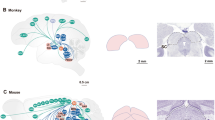Summary
Single unit spikes and evoked field potentials were recorded in different parts and depths of the corpus cerebelli and auricle of immobilized rays before and after stimulating with light, electric fields, touch, tail bending and direct shock to mechanoreceptive nerves of the lateral line.
Discrete areas of the cerebellum are responsive to these modalities and the areas show limited overlap; they are all distinct from the area reported by Plassmann to be responsive to angular acceleration. The visual and tactile-proprioceptive areas are large; the electric area is small. Most units are excited only by one modality.
The tail is represented only in the posterior lobe; trigeminal innervation extends from the posterior onto the anterior lobe, suggesting some topographic projection.
The dynamic characteristics of the responses were examined particulary in the visual units. To a flash, units discharge up to six bursts of spikes in 500 ms. This pattern is reduced at repetition rates > 1/s; above ca. 4/s units tend to fire irregularly. Various kinds of units are found in respect to the succession of responses to short trains of flashes. Some units fire much better to objects moving in a limited visual field with a certain direction and rate.
Similar content being viewed by others
Abbreviations
- EP :
-
evoked potential
References
Aronson LR (1963) The central nervous system of sharks and bony fishes with special reference to sensory and integrative mechanisms. In: Gilbert P (ed) Sharks and survival. Heath, Boston, pp 165–241
Bodznick DA, Northcutt RG (1980) Segregation of electroand mechanoreceptive inputs to the elasmobranch medulla. Brain Res 195:313–322
Boord RL, Campbell CBG (1977) Structural and functional organization of the lateral line system of sharks. Am Zool 17:431–441
Boord RL, Northcutt RG (1982) Ascending lateral line pathways to the midbrain of the clearnose skateRaja eglanteria. J Comp Neurol (in press)
Bullock TH, Corwin JT (1979) Acoustic evoked activity in the brain of sharks. J Comp Physiol 129:223–234
Corwin JT (1978) The relation of inner ear structure to feeding behavior in sharks and rays. In: Johari O (ed) Scanning electron microscopy/1978, vol II. SEM, AMF O'Hare, IL, pp 1105–1112
Corwin JT (1981) Audition in elasmobranchs. In: Tavolga WN, Popper AN, Fay RR (eds) Hearing and sound communication in fishes. Springer, Berlin Heidelberg New York, pp 81–105
Ebbesson SOE, Campbell CBG (1973) On the organization of cerebellar efferent pathways in the nurse shark (Ginglymostoma cirratum). J Comp Neurol 152:233–254
McCormick CA (1981) Comparative neuroanatomy of the octavolateralis area of fishes. In: Tavolga WN, Popper AN, Fay RR (eds) Hearing and sound communication in fishes. Springer, Berlin Heidelberg New York, pp 375–382
Montgomery JC (1980) Dogfish horizontal canal system: responses of primary afferent, vestibular, and cerebellar neurons to rotational stimulation. Neuroscience 5:1761–1769
Northcutt RG (1978) Brain organization in the cartilaginous fishes. In: Hodgson ES, Mathewson RF (eds) Sensory biology of sharks, skates, and rays. Office of Naval Research, Arlington, VA, pp 117–193
Paul DH, Roberts BL (1974) Responses of neurones in the cerebellar corpus of the dogfish (Scyliorhinus canicula). J Physiol 244:47–49 (Abstr)
Paul DH, Roberts BL (1976) Responses of cerebellar nuclear neurones in the elasmobranch fishScyliorhinus canicula. J Physiol 257:43–44 (Abstr)
Platt CJ, Bullock TH, Czéh G, Kovačević N, Konjević Dj, Gojković M (1974) Comparison of electroreceptor, mechanoreceptor and optic evoked potentials in the brain of some rays and sharks. J Comp Physiol 95:323–355
Rizzolo A (1929) A study of equilibrium in the smooth dogfish (Galeus canis Mitchill) after removal of different parts of the brain. Biol Bull 57:245–249
Roberts BL (1981) Central processing of acousticolateralis signals in elasmobranchs. In: Tavolga WN, Popper AN, Fay RR (eds) Hearing and sound communication in fishes. Springer, Berlin Heidelberg New York, pp 357–373
Ten Cate J (1935) Physiologie des Zentralnervensystems der Fische. Erg Biol 11:335–409
Tong SL, Bullock TH (1982) Electroreceptive representation and its dynamics in the cerebellum of the catfish,Ictalurus nebulosus (Ictaluridae, Siluriformes). J Comp Physiol 145:289–298
Tong SL, Lee L, Bullock TH (1982) Distribution of responses to visual, mechanical and electrical stimulation in the cerebellum of catfish and ray. Neuroscience 7 (suppl):S212 (Abstr)
Author information
Authors and Affiliations
Rights and permissions
About this article
Cite this article
Tong, S.l., Bullock, T.H. The sensory functions of the cerebellum of the thornback ray,Platyrhinoidis triseriata . J. Comp. Physiol. 148, 399–410 (1982). https://doi.org/10.1007/BF00679024
Accepted:
Issue Date:
DOI: https://doi.org/10.1007/BF00679024




